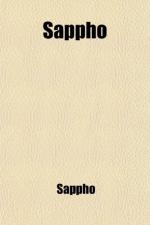|
This section contains 12,084 words (approx. 41 pages at 300 words per page) |

|
SOURCE: "Rose Cut in Rock: Sappho and H.D.'s 'Sea Garden'," in Contemporary Literature, Vol. 27, No. 4, Winter, 1986, pp. 525-52.
In the following essay, Gregory reveals how H.D. evokes the erotic lyricism of Sappho and the elemental power and imagery of the sea in the poems of her Sea Garden.
A familiar shade has haunted the female lyricist and the perception of her work throughout this century—the specter of the Poetess. Within recent tradition the Poetess is identified with the prolific, sentimental "songbird" of nineteenth-century romanticism. Engraved in popular iconography through imaginary and legendary figures such as Emile Grangerford and Elizabeth Barrett Browning, this woman appears as pale and withdrawn, sensitive to the point of neurosis and hysteria, passionate, ecstatic, and morbid. Such a cultural image, surviving into the twentieth century, has negatively affected the critical assessment of women poets. The female lyricist, Theodore Roethke said...
|
This section contains 12,084 words (approx. 41 pages at 300 words per page) |

|


